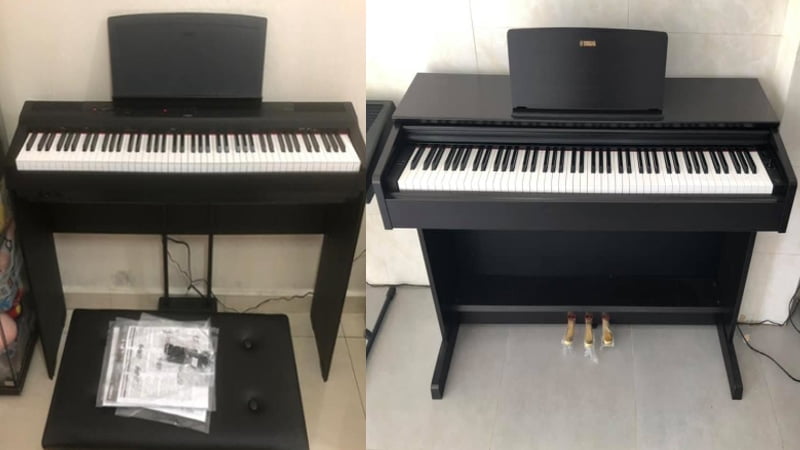Find out why the Yamaha P125 is a better option for pianists in this Yamaha YDP 103 vs P125 review.
When buying a digital piano, one of the most important questions to ask is whether you need a portable or a console digital piano. And since the Yamaha YDP-103 is a classic console digital piano and the Yamaha P125 is the quintessential portable digital piano, comparing these two models is a great way to find out which type of piano is ideal for you.
I tested out these two pianos myself. And while the YDP-103 offered great features for the price, it couldn’t beat the flexibility of the P-125.
Having a console digital piano is great, but it’s also very limiting. On the other hand, even if a portable digital piano won’t offer the same realism as console pianos, you’ll quickly see why they’re the better investment in this Yamaha YDP-103 vs Yamaha P-125 comparison.
Keep reading to see how the P-125 beat out the Yamaha YDP-103 console digital piano.
Yamaha YDP 103 Vs P125: The Comparison Chart
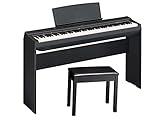



Last update on 2025-07-11 / Affiliate links / Images from Amazon Product Advertising API
Yamaha YDP 103 Vs P125: The Features
Comparing two digital pianos is a pretty tough task. So, for this comparison, I decided to compare both of the pianos based on their features. And after robust testing, I found the Yamaha P-125 to win over the YDP-103 with a score of 2-1.
So, the competition was close. But by the end, the P-125 came out on top because of its versatility. In this section, I’ll get into the details of my review of both pianos to show you why I believe the P-125 to be the better option for most pianists.
Tone
The winner: Yamaha P-125
Tone is probably the most important feature to consider with digital pianos. And between the YDP-103 and the P-125, the P-125 is the clear winner. Not only does it have a more sophisticated tone engine, it has a wider sound library, making it the higher-quality and more versatile pick.
+Tone Generation
Let’s start with how both pianos generate their tones. The Yamaha YDP-103 uses AWM Stereo Sampling. This is the standard tone engine for most Yamaha pianos in this price range. It generates sounds using pre-recorded samples.
However, AWM Stereo Sampling is a bit better than other sampling-based tone generators because it contains more information. Yamaha used high-quality recording equipment to load very detailed and layered samples into the piano, which is how to produce realistic piano tones.
On the flip side, the Yamaha P-125 uses the Pure CF Piano Sound. This tone engine uses samples recorded directly from Yamaha CF Grand Pianos, which are some of the best grand pianos on the market. That way, you get incredibly crisp and bright tones that easily beat out other pianos in its price range.
So, regarding sound quality, the Yamaha P-125 is the clear winner. When I tested both pianos out, I was a bit surprised at how they both produced great tones. But after careful consideration, it was evident that the Yamaha P-125 produces more realistic tones.
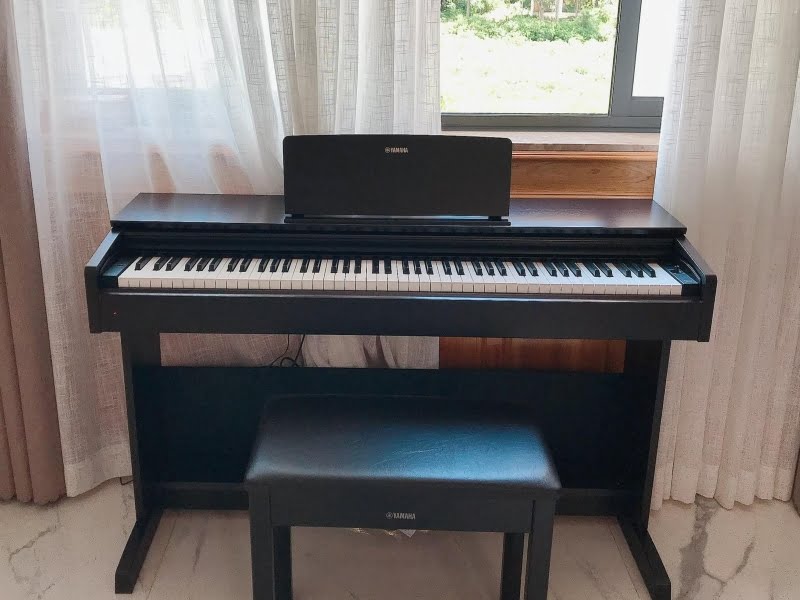
+Sound Library
Another reason the Yamaha P-125 won the tone comparison was its sound library. This piano has over 24 tones loaded into it, which is way more than other digital pianos. The Yamaha P-125 has a fairly wide set of piano tones to choose from, along with electric piano, bass, and string sounds.
This gives players a lot of versatility. That way, you can use the piano for many styles of music. So, whether you’re a rock, classical, blues, or jazz pianist, the Yamaha P-125 has all the sounds you need to fill out the piano’s sonic space.
The Yamaha YDP-103 also has a fairly varied sound library. It comes with 10 different tones, which is already a lot for a digital console piano. And while you get some variety, it simply doesn’t compare to the variety you get on the Yamaha P-125, which is why it lost out in this comparison.
Feel & Playability
The winner: YDP-103
One category where the YDP-103 won out was in terms of feel and playability. As a console digital piano, the YDP-103 feels way more realistic than the P-125. This is primarily due to the hammer action and key texture, both of which are top quality.
While I’m not saying that the P-125 doesn’t have a realistic feel, I found that it wasn’t as good as the YDP-103 in this regard.
+Hammer Action
Let’s start with hammer action.
This refers to the weight of the keys. And luckily, both of these pianos have GHS (graded hammer standard) weighted keys. This is a Yamaha hammer action system designed to emulate the slight weight differences you feel when playing an acoustic piano.
That means the lower keys on these pianos will be slightly heavier than the higher keys. Again, the difference is subtle, but it’s very noticeable, especially if you’re an experienced pianist.
Granted, the GHS system isn’t as good as Yamaha’s GH3, which is used on higher-end pianos. But after testing out other pianos in this range, I found that Yamaha’s GHS system easily beats out others in its price range.
So, if you’re looking for a digital piano with a realistic weight that exceeds its price range, either of these pianos will do you good.
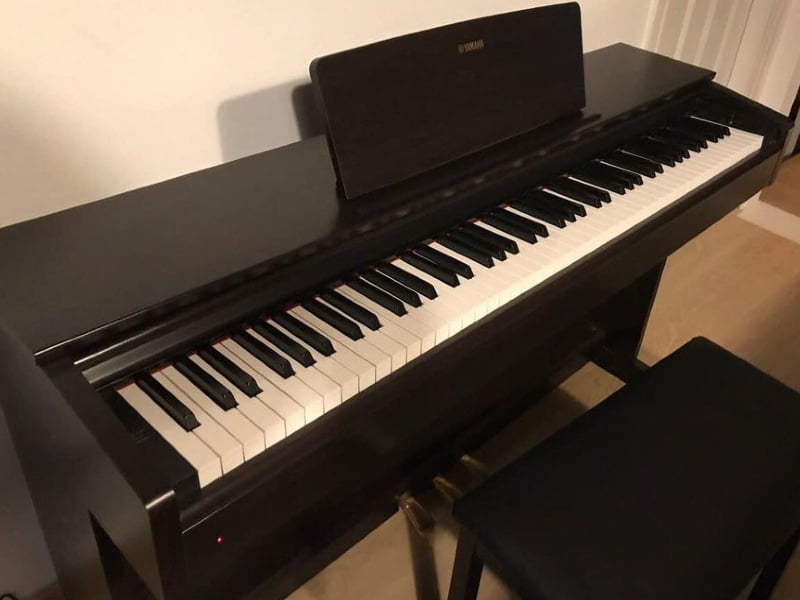
+Key Texture
My biggest complaint with the P-125 is the key texture. Like many other portable digital pianos, the P-125 uses glossy plastic keys. Now, this isn’t that big of a deal because of the great GHS system in place, it does take away a fair amount of the realism.
When I first tested out these pianos, I instantly felt the plastic keys. Since I play many acoustic pianos, the difference is evident. That’s why I really appreciated the fact that the YDP-103 has slightly textured keys.
The YDP-103’s keys have a specific coating that gives off a matte finish and feels closer to the wooden keys of an acoustic piano. Again, they still have a slightly plastic-like feel and aren’t 100% similar to wooden keys, but they definitely do a better job than the P-125’s glossy plastic keys.
The biggest benefit of console digital pianos is that they feel more realistic. And if getting a digital piano with a realistic feel is a top priority for you, then the YDP-103 might actually be the better choice.
Piano Features
The winner: Yamaha P-125
The last comparison point I had with these two pianos was the extra features. This refers to the polyphony, extra playing modes, and effects on the piano. And as you’d expect, the portable Yamaha P-125 comes with way more extra piano features that make this a more flexible piano when compared to the YDP-103.
+Playing Modes
Firstly, let’s look at the playing modes. The Yamaha P-125 comes with split, layer, duo, and recording modes. The YDP-103 only features duo mode, which allows you to split the piano into two smaller pianos which is ideal for piano lessons and duets.
Since the YDP-103 is a console digital piano, it doesn’t need any other mode aside from the duo mode. This is why it’s a great option for piano lessons, but since it lacks some of the other playing modes, this is a pretty limited piano.
The extra modes on the Yamaha P-125 are very useful. You can use split mode to play two separate tones at the same time and make it sound like you’re playing another instrument. Or, you can use layering mode to blend different voices together, creating a unique sound that’s great for live performances.
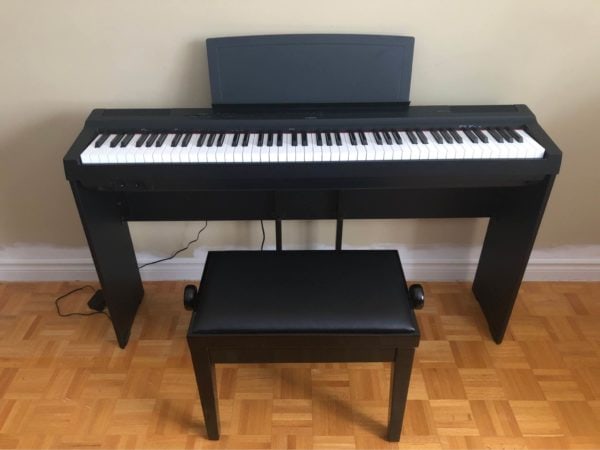
+Effects
The most important effect of having a digital piano is reverb. And luckily, both of these pianos come with reverb effects. However, the Yamaha P-125 takes it a step further by having IAC, resonance control, and a sound boost.
These aren’t exactly ground-breaking effects and only make a slight difference. But if you’re very particular about your tone and you want to have the power to make very slight adjustments to your piano’s sound, the P-125 makes it easier to do that.
+Polyphony
Polyphony isn’t as big of a deal nowadays as it used to be. We have better computers now, so it’s easier to create pianos with large maximum polyphony to play wide and dense chords. That said, the P-125 still has better polyphony than the YDP-103.
The YDP-103 has a 64-note maximum polyphony. This isn’t bad, though, as this is more than enough for playing wide and dense chords. But again, the P-125 has 192-note maximum polyphony, so you can play as many notes as you want even when using the layering and split modes.
Yamaha YDP 103 Vs P125: The Similarities
These pianos aren’t that similar. In fact, I enjoyed making this comparison because of how different they are from each other.
These are two completely different pianos. Despite being made by the same brand and having the same hammer action system, they are very distinct from each other. One is portable and the other is a console digital piano, so you’ll have a hard time making a long list of similarities between the two.
At the end of the day, the Yamaha P-125 is the more flexible option. You have more tones, better sound quality, and all the features you need from a modern piano.
If you’re looking for a piano that you plan on keeping in one place, the Yamaha YDP-103 is a great option. This is one of the most affordable console pianos on the market and is a great buy if you want to have a console piano at home.
But in most cases, I would recommend the P-125 over the YDP-103 because of its versatility.
Quick Rundown of the Yamaha YDP 103
- Your purchase includes One Yamaha Arius Series, YDP103 model | Bench, Owner’s manual & Quick Operation Guide
- Piano dimensions – 53-7/16” W x 32-1/16” H x 16-5/8” | Weight – 82 lbs. | Number of pedals – 3 | Max polyphony – 64 | Number of voices – 10 | Headphones – (2) Standard Stereo phone jack | No recording nor playback capabilities
- GHS weighted action is heavier in the low keys and lighter in the high keys, just like an acoustic piano
- The special matte black key tops are designed to absorb moisture and remain tactile after extended use without becoming slippery
- The controller app for iOS devices adds a rich graphical user interface, allowing for quick and easy navigation and configuration
Last update on 2025-07-10 / Affiliate links / Images from Amazon Product Advertising API
Quick Rundown of the Yamaha P125
- Includes P125B digital piano, L125B furniture stand, BB1 wooden bench
- A fully weighted digital piano with 88 full sized piano style keys
- GHS weighted action is heavier in the low keys and lighter in the high keys, just like an acoustic piano
- The pure CF sound engine faithfully reproduces the tone of the acclaimed Yamaha 9' CFIIIS Concert Grand piano
- USB to host connectivity with MIDI and audio transfer means you only need 1 Cable to connect to your music making software
Last update on 2025-07-11 / Affiliate links / Images from Amazon Product Advertising API
Product Video
Related Articles to Yamaha P125
- Yamaha P150 vs P125: The Battle of the P-Series Models
- Yamaha P125 vs CLP 625: Can a Beginner’s Digital Piano Match the Clavinova?
- Yamaha P125 vs Roland FP 60: Which is the Better Investment?
- Yamaha P-121 vs P-125: Finding the Best Portable Yamaha Piano
- Yamaha P125 vs Korg LP 380: Which Piano Is Better for Your Needs?
- Yamaha P125 vs P85: Can the Outdated Digital Piano Beat the Newer One?
- Yamaha P125 vs DGX 670: Which Piano Comes Out on Top?
- Yamaha P125 vs Korg SP 280: Which is the Better Beginner’s Digital Piano?
- Yamaha P-255 vs P-125: Finding the Better Option for Beginners
- Yamaha P125 vs YDP S34 Comparison: Does the Portable P125 Hold Up Against a Console Digital Piano?
- Yamaha P125 Vs YDP 164: Should You Get A Console Or Digital Piano?
- Yamaha P125 Vs Kawai ES110 Comparison: Which Is The Best Portable Digital Piano
- Yamaha P125 vs Casio PX S1000: Which Digital Piano Is Worth Your Money?
- Casio PX-870 Vs Yamaha P-125: Should You Get A Portable Or Console Digital Piano?
- Alesis Recital Vs Yamaha P125: Which Is The Right Pick For You?
- Yamaha P45 VS P115: Which P-Series Newbie Gives You More Value for Money?
- Alesis Recital Pro vs Yamaha P125 Comparison: Which Is The Best Portable Digital Piano?
- Alesis Prestige Artist vs Yamaha P125 Comparison: Why the Yamaha P125 Is the Better Investment
- Yamaha P125 vs Casio PX-770 Review: Why the Yamaha P125 Beats Out the Casio Console Digital Piano
- Yamaha P125 vs DGX 660 Comparison: Can the P125 Hold Its Own Against the DGX 660?
- Yamaha P125 vs Roland FP-30X Review: Why the Roland FP-30X Comes Out On Top
- Yamaha P125 vs P515 Review: Why the Yamaha P515 Is the Better Investment
- Yamaha P115 vs P125 Review: Can the P125 Beat Out Its Predecessor?
- Yamaha P125 vs Roland FP30: A Close Battle Between Two Great Digital Pianos
- Yamaha P45 vs P125: Why the Yamaha P125 Is the Better Pick for Pianists
- Yamaha P71 vs P125: Why the Yamaha P125 Is the Better Investment
Related Articles to Yamaha Ydp 103
References:
- Yamaha P125: https://www.sweetwater.com/store/detail/P125BK–yamaha-p-125-88-key-weighted-action-digital-piano-black
- Yamaha YDP 103: https://www.sweetwater.com/store/detail/YDP103R–yamaha-arius-ydp-103-digital-home-piano-with-bench-rosewood
Lulacruza is an electronic folk duo operating at the junction of the hypermodern and the ancient. Our music weaves together hypnotic female singing, South American folk instruments and electronic processing, while channeling pulsating waves from the source of creation.
Lalucruza is also a community where you can connect with other music lovers to collaborate, exchange ideas and share knowledge. A platform for who wants to learns the basics of playing piano, guitar, drum masters’ technique, etc.. is the premise of our website.
